In Costa Rica, nature comes first
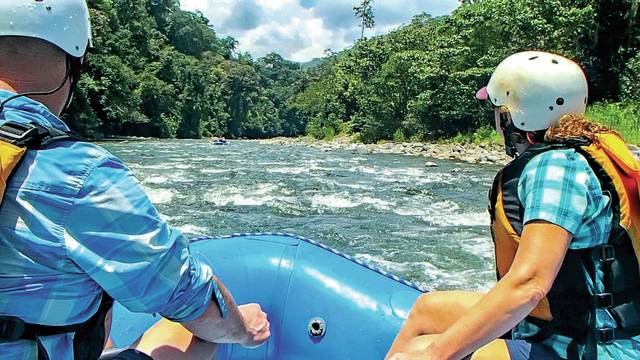
River runners rafting to Pacuare Lodge encounter easy Class 2 rapids getting there; and when they leave, heart-pounding class 4 and 5 rapids downstream. (Steve Haggerty/TNS)
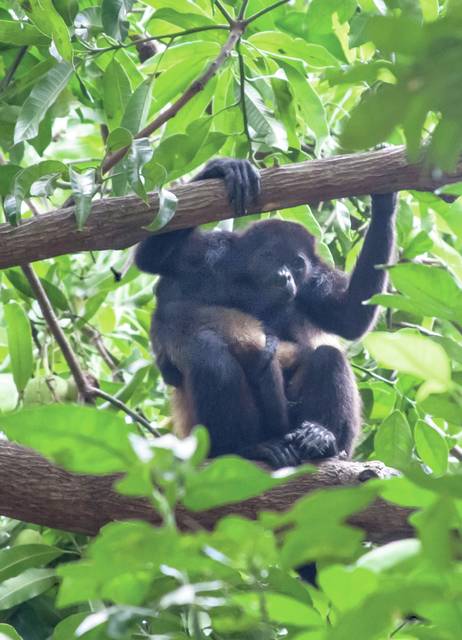
Howler monkeys, kings of the rain forest canopy, are hard to see but easy to identify; listen for their loud throaty howls. Though nine species have been identified, Costa Rica is home to just one, the common mantled howler. (Steve Haggerty/TNS)
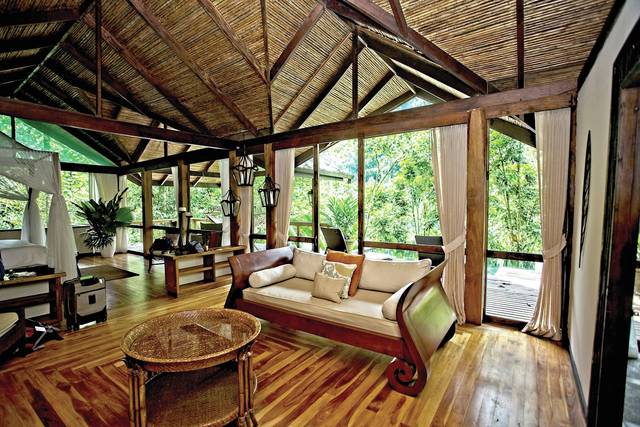
The luxurious Linda Vista Suites, high up in the rain forest canopy and with screened walls on three sides feels like being outdoors. (Steve Haggerty/TNS)
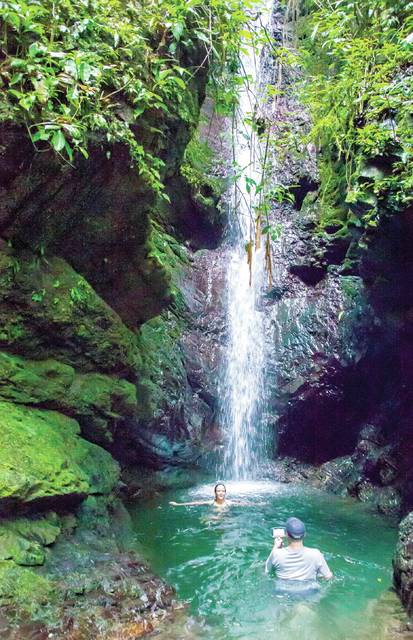
A half-hour’s hike from Pacuare Lodge leads to a hidden waterfall. (Steve Haggerty/TNS)
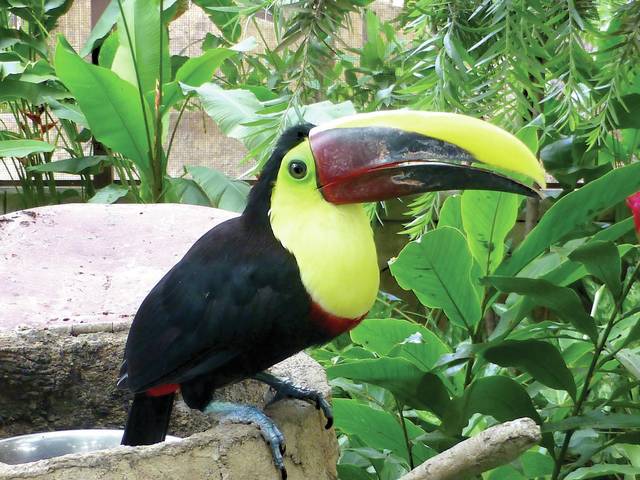
Keel-billed toucans, bright-colored and slow-flying, are easy to spot in dense rain forests like those in the Pacuare River gorge. (Steve Haggerty/TNS)
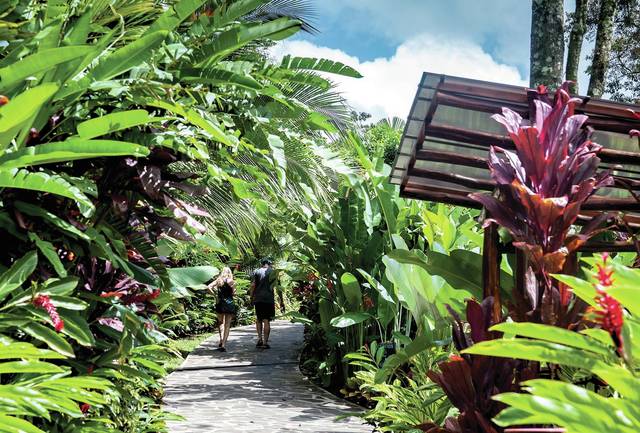
Hike through the grounds at Nayara Springs Resort and get lost in the landscaping, a green with tropical plants and flowers crowding every path, enhancing every pool and flanking every restaurant. Highlighted by fully grown trees, with bushes, flowers and even animals - large, strange birds and families of sloths - the botanical gardens are what make this luxurious, full-service resort so unique. Most plants are native species; all are identified by a common and scientific name. (Steve Haggerty/TNS)
TURRIALBA, Costa Rica — It was 6:01 a.m. when we heard them barking, an insistent “huh-huh-huh-huh” floating through the rain forest canopy and over Pacuare Lodge.
TURRIALBA, Costa Rica — It was 6:01 a.m. when we heard them barking, an insistent “huh-huh-huh-huh” floating through the rain forest canopy and over Pacuare Lodge.
“Howler monkeys,” said Steve, squinting at his watch. Then a toucan weighed in, two long, raspy “screeches” close to our deck, in the Rio Pacuare Forest Reserve, in eastern Costa Rica’s Barbilla National Park.
ADVERTISING
Up in a flash, we grabbed the binoculars and dashed outside, where a chorus of honks, chirps and whistles ushered in the dawn.
“Shhhh!” Steve said, hopefully, peering over the railing into the underbrush. “Listen! Was that a growl?”
Wildlife on parade is a predictable event at most Costa Rican eco-lodges. Coatis, capuchin monkeys, birds and butterflies lead off, followed by sloths, bacillus lizards (Jesus lizards because they “walk” on water) and green frogs, with howler monkeys, tapirs, armadillos and tarantulas at the rear. But big cats, ocelots and pumas? Once in a green moon.
“Jaguars? Maybe, but don’t count on it,” said travel planner Alison Carey, three months earlier when she called to talk about our trip. A Latin America specialist with Scott Dunn Personal Journeys, Carey and her colleagues research and book custom, personalized adventures for individual travelers.
We’d been to Costa Rica before, but just briefly, on a cruise ship stopover. This time would be different, we agreed. Hence the call to Scott Dunn Personal Journeys, a leader in the growing trend toward custom travel.
“You’ll like Pacuare Lodge,” Carey said. “It’s on the river, an easy, 4-mile raft ride downstream. It’s known for wildlife, and wild cats, too, though they’re rarely seen. It’s isolated, but that’s part of the appeal. You know what they say: Costa Rica is one of Central America’s safest countries.”
Was it? Sporadic upheavals have plagued Central America for decades, from corrupt governments and armed insurrections to civil wars and more recently, drug trafficking. What makes Costa Rica different?
Then our itinerary arrived in the mail, a spiral-bound notebook listing dates, places and our contacts at each, with blank space for notes. The last three nights would be on our own, joining well-heeled friends for a reunion at Villa Manzu, a palatial mansion on the Papagayo Peninsula.
But the question lingered.
“Is it true? Is Costa Rica Central America’s safest country?” I asked Abel, the Scott Dunn driver who picked us up at the Juan Santamaria International Airport, in San Jose, the capital.
“We think so,” he said, heading for the Finca Rosa Blanca hotel, north of the city.
“It’s because we have no military,” he continued. “The money pays instead for schools, high school and college, and for health care and doctors. And it’s all free,” he said.
“Of course, there are always people who don’t want to work and are tempted to steal. But most people here have jobs,” he added as we reached the hotel, a restored, 14-suite Spanish Colonial house and coffee plantation, with a pool and a popular open-air restaurant.
On time for the day’s coffee plantation tour, we thought we’d learn about coffee. But the two-hour uphill walk with naturalist Manolo Munoz was as much about sustainable farming as it was about a good cup of joe.
Guiding us among the coffee trees, planted in volcanic soil between banana and poro trees in a mixed-species forest, Munoz explained that “trees add important minerals” to the soil. “A mix of sun and shade grows better ‘cherries’ (coffee beans) than the big commercial farms do,” he said.
That evening, as the sun slipped between the palm fronds and Miguel, the hotel waiter, came around with menus, I decided to see what he’d say. “Uh, Miguel, why do people say Costa Rica is Central America’s safest country?”
“Because we don’t have an army,” he said. “After the civil war, in 1949, the government decided that paying for education, hospitals, culture and parks was more important than guns and soldiers.”
Local police handle regional crime and a national government-supported 70-man team of “commandos,” a trained “security and intervention” group, is available for extreme emergencies. But beyond that, no army.
In Costa Rica, we learned, education, health and the environment are more than a campaign promise. They are the framework for a peaceful future.
No wildlife conversation lasted more than 10 minutes before the topic turned to Costa Rica’s many species, and how they adapted to the country’s 12 climate zones, each at a different altitude, from sea level to the summit of frosty, 12,533-foot Cerro Chirripo Volcano.
Rafting through the Pacuare River’s narrow gorge, to Pacuare Lodge on the river bank, we could see the difference between the trees along the river gorge and those on the mountain side above, where the howler monkeys live.
Alone in the forest, Pacuare Lodge is self-sustaining (electricity is limited to several hours daily), rustic and luxurious. Candles light the upstairs bar and hall, and the dining room downstairs and adjoining deck, where all meals are served. Most of the bungalows have some screened walls, bringing the outside in. The first group were built along the river; the luxury suites climb the hill, each a five-star treehouse.
Our days were busy with discovery hikes, wildlife prowls and trips to the nearby indigenous village, with an occasional plunge pool dip and nap in our hammock. Leisurely dinners with like-minded guests made the rain forest silence that much more serene.
A startling contrast, indeed, to our next destination, Nayara Springs Resort, on a highway near Avenal Volcano National Park, in central Costa Rica. Greeted by a uniformed bell boy, we thought we’d made a wrong turn.
But this popular vacation village and honeymoon retreat only masquerades as a hotel. In fact, it offers urban sophistication in a rain forest setting. With its sumptuous suites — and swimming pools, shaded patios, bars and pubs, a spa and gym, restaurants and shops — connected by a maze of heavily landscaped serpentine paths, each is hidden from the next. A five minute walk beneath the trees — with resident birds and 30-odd sloths overhead — was a stroll in the woods.
As our Scott Dunn-planned trip ended, we said goodbye to our driver, Andreas, who delivered us to Villa Manzu. And there was the mansion, overlooking the ocean, a modern, sandy-colored stone building flanked by grassy lawns and trees, pools and patios.
Art and artifacts lined the corridors and walls. The kitchen-plus-barstools adjoined the living and dining rooms; the theater, two bars, party room and eight luxurious bedrooms with bath completed the luxury. A path to the cliff-side barbecue circle faced the sunset.
With a staff of 12, including butler and three chefs, this hideaway, on 5 acres, guarantees privacy for those who can afford it: celebrities, tech-company millionaires, movie moguls, industry titans and sports greats. For us, being there was dumb luck.
“Make yourself at home,” said our hostess, with a warm hug. “Take in the scenery,” or join us in the pool; it’s heated. “Meet our butler, Luis Morera, who makes the most marvelous cocktails.”
Sit at the kitchen counter and “talk ingredients,” with the chefs, or “ask about wine-pairings.” Borrow a kayak or fishing gear and “walk down to the beach.” Take a car, to visit the Beach Club or play golf. “Villa Manzu has guest privileges.” Arrive by yacht and tie up in the harbor. Or fly: “The driver will meet you at the airport.”
The Villa sleeps 20-plus adults and/or children. Because this is your house, everything’s included: Meals, wine, cocktails, snacks, sports equipment, fishing gear, a car, guides and, as always, Costa Rican hospitality.
Anne Z. Cooke writes about travel and its effect on global warming. Contact her at travelswithanne@cs.com or on Twitter at @anneontheroad.
———
THE NITTY GRITTY:
IF YOU GO: Scott Dunn Personal Journeys, a leader in the newest trend in travel, researches, plans and books personalized vacations and adventures. www.scottdunn.com.
All lodging prices may vary with discounts, dates and availability.
THE LODGES:
At Finca Rosa Blanca, double rooms start at $254 per night; www.fincarosablanca.com/en
At Pacuare Lodge, rates for two in a bungalow with meals, most recreation and non-alcoholic beverages start at $766; three nights are recommended. www.pacuarelodge.com
At Nayara Springs and Nayara Resort, bungalows for two start at $351, but vary with discounts and availability. www.nayarasprings.com.
At Villa Manzu, the all-inclusive rate for the house is priced per night. Multiple guests, groups and families can share the cost. Call for dates, availability and current prices. www.villamanzu.com.
GOING THERE: Fly into Juan Santamaria International Airport, in San Jose. For Villa Manzu, in Guanacaste Province, fly into Liberia Airport.


